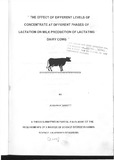The effect of different levels of concentrate at different phases of lactation on milk production of lactating dairy cows
Abstract
Eighteen lactating dairy cows were used to determine the effects of
reallocation of a fixed amount of concentrates during the different phases of
lactation on milk yield (both during period of feeding and total lactation yield) and
live weight changes. The cows were randomly allocated to treatment groups as
they calved. The design was randomised complete block design. There were two
breeds {Friesians (405±21 kg) and Ayrshires (394±18 kg) each with nine cows}
and three parities (2, 4 and 6) making six blocks. The cows were randomly
assigned to the three treatments. The cows selected were to calve within two
months.
Animals in treatment 1 received 2 kg /day of concentrate for 305 days
while those on treatment 2 received 4kg/day of concentrate for first 150 days of
lactation and those on treatment 3 received 8 kg/day of concentrate for first 75
days of lactation. For cows in treatment 2 concentrate feeding ceased after 150
days and those in treatment 3 after 75 days. This ensured that the same amount
of concentrate was used for all treatments. The basal diet was based on pasture
supplemented with Rhodes grass hay.
Throughout the lactation of 305 days, milk yields were recorded daily and
2-day composite samples were taken per week over 12 weeks of lactation for fat
analysis. The liveweight and body condition scores of the cows were recorded
once a week throughout the lactation. Blood samples were obtained from jugular
vein of all the cows for the first 12 weeks of lactation. The blood was analysed for
blood urea nitrogen (BUN) and total plasma protein (TPP).
The mean total lactational yields (305 days) were similar for treatment 1
and treatment 2 (2543.6 kg and 2563.2 Kg respectively) but significantly higher
(P<0.05) for treatment 3 (3155.0 Kg). This difference was attributed to
significantly higher yield in earlier phase of lactation (12 weeks) for the treatment
3 group. No differences in yield were noted in later phases of lactation (P<0.05).
There was no significant effect of level of concentrate on milk fat during the first
12 weeks of lactation.
Live weight changes varied between treatments. All the treatment groups
experienced a period of weight loss in early lactation (to 6 weeks) before starting
to gain steadily thereafter, In the first phase of lactation cows in treatment 1 and
treatment 2 had a negative liveweight gain, -379 and -162 g/day, respectively
while liveweight gain of cows in treatment 3 was 187 g/day which was
significantly different (P<0.05) from the former groups. The mean body condition
scores for the whole lactation were 3.00, 2.90 and 2.85 for treatments 3, 2 and 1
respectively. No significant differences (P>0.05) were observed in liveweight gain
between treatments in the last 230 days of lactation. Treatment 3 had
significantly higher (P<0.05) body condition score than the other groups in
phases 2, 3 and 4. Blood urea nitrogen (BUN) and Total plasma protein (TPP)
were not significantly affected by level of concentrate supplementation.
The important finding from this study was that concentrate reallocation to
the first phase of lactation improved productivity of the dairy cows at no extra
cost. It demonstrated that it is possible to extract 611 kg of extra milk during the
cow's lactation by feeding the same amount of concentrate during early lactation
at 8 kg/day during the first 11 weeks after calving. The study also showed that
concentrate feeding can be withdrawn for the rest of lactation period without
lowering milk production below that of cows that continue to be fed at a flat rate
of 2 kg/day throughout their lactation.
Citation
Master of Science in Animal SciencePublisher
University of Nairobi Department of animal production

